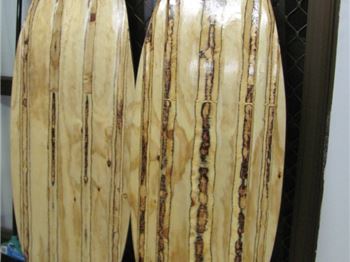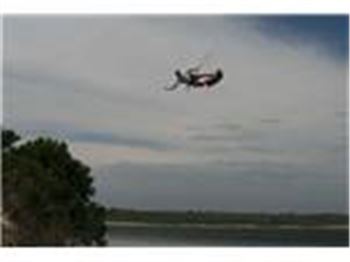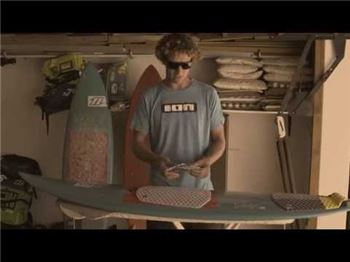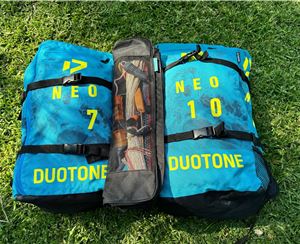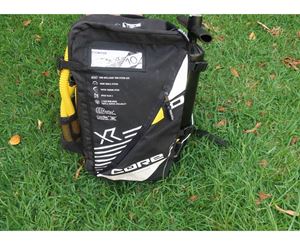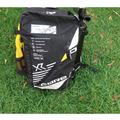|
KiteCam for Kitesurfing -
now available in our online store

Kite Cam Rig 4
|
 |
- Which Camera ?
Pentax Optio W10 / W20 / W30 / W60 vs. Olympus Stylus 790 SW
When you attach a camera on a kite, size and weight matter. Therefore, I looked for the smallest digital cameras that do not require any cumbersome waterproof case.
As I'm writing this page (November 2007) there are mostly 2 waterproof digital cameras available on the market, the Olympus Stylus 790 SW and the Pentax Optio W10 / W20 / W30 / W60.
I tested both and here are my conclusions :
| Name |
Olympus Stylus 790SW 7.1MP
|
Pentax Optio
W10, W20, W30 and W60 |
Photos |
 |
|
Memory Card |
xD Card, only by and for Olympus.
Max size : 2GB
|
SD/SDHC Card, very standard, affordable and easy to find.
Max size : 16GB
|
Video Format |
640 x 480, 30 fps
(DVD quality)
|
640 x 480, 30 fps (DVD quality)
W60 only : 1240x720, 15fps (HD) |
Video Length |
30 minutes with 2 GB card
(Max size)
|
up to 60 minutes with 4GB SD card,
4 x 60 minutes with 16GB SDHC card
W60 : 32 minutes only, 2GB max per file.
|
Lens position |
The lens is not centered, not easy to mount and position. |
Lens conveniently centered in the front of the camera body, easier to mount and position. |
Lens Cover |
Mechanical sliding cover flap, protects the lens when camera is off, but can easily get stuck with sand or dust. |
No lens cover, reduces mechanical problems with sand. |
Interval Shoot |
Nope.
Simply impossible to take photos while kitesurfing. |
Yes! 1 photo every 10 seconds for up to 1000 photos! (2h46!)
|
Image Size |
7.1 MegaPixels (but unusable on the kite.) |
W10 : 6.1 MegaPixels
W20/W30 : 7.1 MegaPixels
W60 : 10 MegaPixels
|
| In Conclusion |
Nice camera but not ideal for Aerial Kitesurfing Photography |
Recommended
for Aerial Kitesurfing Photography |
In conclusion, although the Olympus is nice and stylish, the Pentax Optio turns out to be a better choice for what we want to do : attaching it to a kite and having it shooting automatically for as much time as possible.
Here again, size matters! Now up to16Gb are available and pretty affordable.
1Gb and 2Gb will work too, but 15 or 30 minutes kitesurfing goes way too fast!
You can use a USB/SD card adapter to download your files on your computer, it goes faster than using the camera and its USB cable.
|
Speed : 150 x works just fine with the W10/W20/W30, even in best resolution video and photo.
Notes about the 8+GB SDHC cards :
It seems that the W10 and W20 can not generate movie files bigger than 4Gb.
If you are using a 8+Gb SDHC card and let it shoot for more than 1 hour (at best quality : 640, ***, 30fps), it will stop at 4.194 Gb and the movie file will be corrupted.
Therefore, I do not recommend using cards bigger than 4Gb on the W10 and W20.
Pentax must have notice this bug, since they blocked the max file size on the W30 to 4Gb, even if you have a 8 or 16 Gb SDHC card.
So this lets you shoot 2 or 4 x 60 minutes (2 or 4 x 4Gb). (You have to return to the beach after the first hour of shooting, land your kite, remove the W30 from the mount and start shooting another 4Gb clip. Do not forget to turn the LCD Off if you want to shoot that much time with the same battery).
I've also been told that some more recent W20 have this 4Gb blocker...
Another thing to know about the SDHC card : they need a special USB/SDHC adapter if you want to download it without using the camera.
If you use the USB cable of the camera, it takes for ever, more than 1 hour for 2 clips of 4Gb.
The Kite Cam Rig Version 4 (KCR4) is a camera case customized with a hole for the lens and straps to attach onto the central strut of the kite.

This mount is water-resistant, and cushioned to protect the digital camera.
It is custom-made for the Pentax Optio W10, W20, W30 or W60.

- Will the Kite Cam Rig work with my kite?
You can use this system for your kite only if the central strut is not completely stitched to the canopy near the leading edge, below the valve.
Otherwise, you might be ok with a special brace around the strut.
Either way, check the compatibility list by kites brands and models below.

To fit the Kite Cam Rig, the circumference of the central strut should be
between 25 and 40 cm (~10 and 16 inches),
or the diameter of the strut should be between 8 and 13 cm (~3 and 5 inches).

- Compatibility with kites by brands, models and years.
So far, the Kite Cam Rig has been tested with the following kites :
| Brand |
Model |
Year |
Compatible? |
| Cabrinha |
Crossbow |
2006-2009 |
Yes! |
| Cabrinha |
Contra |
2006-2008 |
Yes! |
| Cabrinha |
SwitchBlade1,2,3 |
2006-2008 |
Yes! |
| Cabrinha |
Omega HD |
2008 |
Yes! |
| Cabrinha |
Revolver HD |
2008 |
Yes! |
| Slingshot |
Fuel |
2003 |
Yes! |
| Slingshot |
Fuel |
2006-2007 |
No. |
| Slingshot |
Octane |
2006 |
No. |
| Slingshot |
Turbo Diesel |
2006 |
Yes! |
| Slingshot |
Turbo 2 |
2007 |
Yes! |
| Slingshot |
Rev |
2008 |
Yes! |
| Flexifoil |
Ion |
2006-2007 |
Needs strut brace |
| Naish |
Shockwave |
2007 |
Needs strut brace |
| Naish |
Torch |
2007 |
Needs strut brace |
| Naish |
Raven |
2007 |
Needs strut brace |
| Naish |
Helix |
2008 |
Yes! |
| Naish |
Alliance |
2008 |
Yes! |
| North |
Rebel |
2007 |
Yes! |
| North |
Rhino |
2007 |
Yes! |
| North |
Vegas |
2006-2007 |
Yes! |
| Ocean Rodeo |
The One |
2006 |
Yes! |
| Ocean Rodeo |
Rise |
2007-2008 |
Yes! |
| Best |
Waroo |
2006-2008 |
Yes! (deflate a bit first) |
| RRD |
Hyper Type |
2006 |
Yes! |
| RRD |
Type 8 |
2006 |
Yes! |
| GK |
Sonic, VSonic, Trix |
2006-2008 |
Yes! |
| Catapult |
Jocker |
2007 |
Yes! |
| Caution |
Spit Fire |
2007 |
Yes! |
| Caution |
Spit Fire 2 |
2008 |
Needs strut brace |
| Caution |
Answer |
2007 |
Needs strut brace |
| Liquid Force |
Assault |
2007 |
Yes! |
| Airush |
Vapor |
2007 |
Yes! |
| F-one |
Bandit |
2008 |
No. |
| EH |
EZE |
2008 |
Yes! |
| EH |
Beast |
2008 |
Yes! |
| Eclipse |
Thunder |
2007-2008 |
Yes! |
| Ozone |
Instinct |
2008 |
Yes! |
Disclaimer
There are so many brands and models are changing every year, that this list is difficult to keep up-to-date.
It is accurate, to the best of our knowledge. Still, it's recommended you to double check how far the central strut of your kite is stitched to the canopy before ordering a Kite Cam Rig.
Different kites (brand, size) need different adjustment of the camera angle.
You adjust this angle by increasing or reducing the length of the legs held Velcro cuffs of the back strap.

Most likely, you will have to go through some trial and error until you get the framing right.
At first, the kitesurfer will be too far ahead or too far behind and out of frame, so you will need to adjust the angle between the Kite Cam Rig and the strut.
Here is how the angle of the camera mount affects the framing:

Once the camera mount is attach to the kite and you are ready to go kitesurfing,
turn the camera on (photo mode or video mode, see below) and start shooting,
slide it inside of the mount, zip it and go kitesurfing.

The Interval Shooting mode is awesome to let the camera shoot automatically up to 7 MegaPixel photos while you are surfing.
Unfortunately the interval can not be shorter than 10 seconds, so you just have to be lucky to get shot at that perfect right moment when you are jumping. Still, you end up with 100s of photos, most of them very similar and hopefully some really cool ones.
One bug with the Pentax Optio (W10,W20,W30): it is very difficult to interrupt the Interval Shooting mode once started when you are in 10 seconds interval, without removing the battery..
Here is how it works:
When shooting in interval Shooting mode, the camera goes through 4 cycles :
- Waking-up (3 seconds),
green power LED goes on,
LCD screen goes on.
- Taking the photo (1 second),
LED on,
LCD Off.
- Saving the data (4 seconds),
LED blinking,
LCD On, but black.
- Sleeping phase (10-(3+4+1) = 2 seconds )
LED Off,
LCD Off
The interruption "can" only happen during the Sleeping phase :
1) Press the power button (green LED), then the LCD goes on after 1 second and displays
some information.
2) Press the menu button, and you get a message asking to press OK if
you want to interrupt.
3) Press OK, you get the message "interval
shooting is completed" and the camera goes off.
A lot to happen in a 2 seconds sleeping phase!
The trick is first to increase the interval. Try with 20 or 30
seconds to understand how it works and practice.
Then reduce the interval. It's almost impossible to do it with the
minimum 10 seconds. You have to start pressing the power button as
soon as it stops blinking (end of phase 3), wait for about 1 second until the LCD goes on, then
immediately press "menu" and then "OK". It's specially challenging
outdoor when you can barely see the LCD blinking.
You will already increase your chances of success by raising the
interval to 11 or 12 seconds, which extends the Sleeping phase to 3 or 4 seconds. Good luck!
Otherwise, removing the battery always works, but not the best thing to do with wet and sandy fingers.
It seems to be a little easier with the W60, or maybe I'm just getting better at it over the years...
Videos shot from the kite can be amazing
Make sure you start the camera correctly and do not turn it off by accident while positioning it in its mount on the kite.
Something that I am missing from the Olympus Stylus SW, is the fast-forward features, available while viewing videos. With the Pentax, you can only play it at normal speed, quite inconvenient when the first 5-10 minutes of a 60 minute clip are a close up of the sand under your kite waiting to be launched, or the kitesurfer struggling to catch a gust.
A good idea before inserting the camera in the mount, is to turn the LCD display off ("OK" button). Battery will last longer.
Photo mode
"P" (Program) works fairly well with default settings. If not, you can test the following modes :
"Sport" is supposed to have a faster shutter speed and be sharper.
"Digital SR" is also supposed to reduce camera shake by increasing shutter speed and sensitivity.
No zoom for photos
For kitecam photos, I do not use any zoom.
The 7 megapixels resolution is big enough to crop in later (in Photoshop for instance) if I need to frame closer to the kitesurfer.
If the image has to be rotated, I have better margin to re-crop after.
Also I like to see the ocean, the waves and foam as far as possible.
Slight zoom for video
For Kitecam video, you can not really crop in post-production, so in order to get a little closer to the rider, you can zoom about 1/3 of the full range.
Beyond 1/2 of the max zoom, the shaking will be too amplified, the image instable and the kitesurfer will go out of frame too often.
Focus
Infinity or Manual + infinity work best.
Auto Focus (default) might get blurry every now and then, specially when the kite moves too fast, like during jumps, but overall most of the photos should stay sharp.
Focus after crash
In case of violent impact during a photo or video shoot (kite crashing for instance), the unique mechanical parts of the camera (optic) might move and the lenses might keep shooting everything out of focus until the end of your session.
Fortunately, this goes back to normal after restarting your camera.
Light condition
Overall, photos and videos tend to be sharper in sunny and bright condition, and more blurry in overcast and cloudy weather, or after sunset.
Most of the time, your kite is not supposed to fall in the water so it should not be an issue. Still, I have crashed my kite in waves, it got severely torn in pieces and submerged repeatedly for awhile until I was able to bring it back to the beach. The camera went through that kitemare without any problem, taking photos all the way.
That said, I've heard people reporting leaking problems after using their Pentax camera for diving in the ocean or in a swimming pool.
I guess the Pentax Optio W cameras are as waterproof as advertised when brand new, with no sand or dust in the rubber flap for the battery, but that probably don't last forever. These cameras are great to be used above the water, get wet or submerged by accident every now and still survive, which is perfect for kitesurfing for instance. But I would not recommend them for intense underwater activities.
Pentax is probably aware of this weakness, and they seem to be pretty good at fixing or replacing the damaged camera if it is still under warranty.
When you let your camera shoot automatically while you are sailing, you can not check what the camera is doing, so you have to be prepared.
Tip #1: Don't wait to be at the beach to learn how to use the camera!
The Pentax Optio is a great waterproof digital camera with unique features, but its interface is not the most intuitive. When you will be about to launch your kite, you won't have much time to figure out the menus and settings. Spend some time in advance experimenting with the different modes and options you will need to use with the KiteCam Mount.
Here is a list of other tips I have learned from my mistakes:
- In video mode, make sure you do not turn the camera off accidentally while installing it on the kite.
-
Zoom : make sure the option Digital Zoom and Optical Zoom in Rec Setting menu are turned off. Otherwise, the zoom button is still active while shooting and might get pressed accidentally inside of the mount.
- You can switch off the LCD display while shooting by pressing 3 times on "Ok". Battery will last longer.
- After backing up your photos and videos on your computer, do not forget to delete them from your SD card, or you might run short of memory during the next shot.
- Once you set the Interval Shooting mode, by changing other options on the camera, you might lose your Interval Shooting mode setting. To make sure it is set up properly, wait for the second photo to be shot before placing the camera in its mount.
- Do not use the camera strap that comes with its original package. It will get in the way when mounting the camera on the kite.
- Try to keep the lens clean. It's not always easy when you are on the beach, but if it's too dirty, find a smooth cloth or something to clean it. No blurry photos.
- Rinse camera with clear water after the ocean.
|












